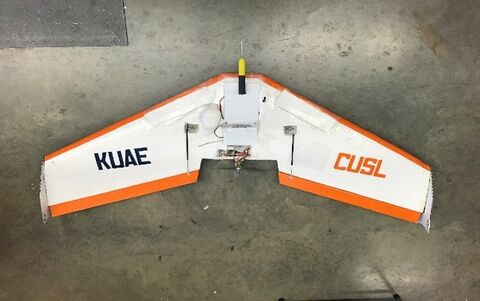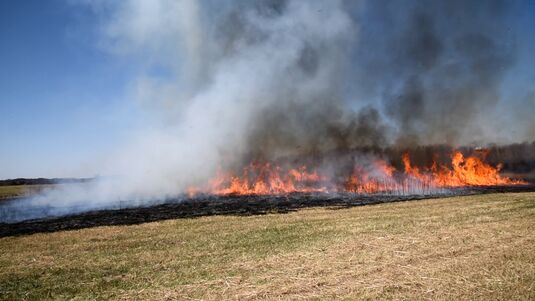UASFireWorkshop2024: Difference between revisions
Chaohaiyang (talk | contribs) 2024 UAS Integration for Fire Operation Workshop (KU) |
Chaohaiyang (talk | contribs) No edit summary |
||
| (7 intermediate revisions by the same user not shown) | |||
| Line 44: | Line 44: | ||
</html> | </html> | ||
== | ==2024 UAS Integration for Fire Operation Workshop (High-Resolution Data and Digital Twin for Wildland Fires)== | ||
[[file:KHawk55Thermal.jpg|480px|]] | [[file:KHawk55Thermal.jpg|480px|]] | ||
[[file:Fire.jpg|535px|]] | [[file:Fire.jpg|535px|]] | ||
| Line 51: | Line 51: | ||
---- | ---- | ||
===Introduction === | ===Introduction === | ||
The goal of our workshop is to bring together UAS developers and | The goal of our workshop is to bring together UAS developers and users, prescribed fire or cultural burn operators, wildfire fighters, and emergency response agency for idea exchange and discussions on community needs for fire/wind/smoke data, model, and digital twin. Please email Dr. Haiyang Chao (chaohaiyang AT ku DOT edu) for the meeting Zoomlink if you would like to join the meeting. | ||
Time: | Time: 12:30 – 3:30 PM CDT, 2024/10/30(Wednesday) | ||
Sponsor: | Sponsor: NSF FirePlan Grant and NSF Smart & Connected Community Grant | ||
Contact: Haiyang Chao, Ph.D. & Associate Professor, Aerospace Engineering Department, University of Kansas | Contact: Haiyang Chao, Ph.D. & Associate Professor, Aerospace Engineering Department, University of Kansas | ||
---- | ---- | ||
===Workshop Program === | |||
Introduction & Opening (12:30 - 12:45 PM CDT) | |||
Forum 1: Fire Data Standards for Model Validation (12:45 PM - 1:45 PM CDT) | |||
12:45 - 1:00 PM, “Fire and wind metrics measurements during prescribed grass fires using small UAS”, Haiyang Chao (KU) & Ming Xin (Mizzou) | |||
1:00 – 1:15 PM, “Data needs for fire model evaluation”, William Mell (USFS) & Derek McNamara (Geospatial Measurement Solutions, LLC) | |||
1:15 - 1:45 PM Discussion: data types, fuel/fire/wind/smoke metrics (e.g., rate of spread, flame height, flame length, FRP), and data collection suggestions for various user groups (e.g., prescribed burn association, university prescribed fire operators, fire behavior researchers). | |||
Forum 2: Fire spread model and digital twin (1:45 - 2:30 PM CDT) | |||
1:45 - 2:00 PM, “Fire spread model and data assimilation”, Xiaolin Hu (Georgia State U.) | |||
2:00-2:30 PM, Discussion: digital twin requirement from different user groups, gaps in existing fire spread models. | |||
Forum 3: Community data and modeling needs (2:30-3:15 PM CDT) | |||
2:30 - 2:45 PM “Cultural burn and prescribed fires”, Melinda Adams (KU) and Sheena Parsons (Kansas Biological Survey) | |||
2:45-3:15 PM Discussion: shared and diverse community needs for fire data, model, and digital twin (e.g., prescribed fire vs. cultural burns vs. wildfires). | |||
Conclusion and Summary (3:15-3:30 PM CDT) | |||
Latest revision as of 14:02, 2 October 2024
2024 UAS Integration for Fire Operation Workshop (High-Resolution Data and Digital Twin for Wildland Fires)
Introduction
The goal of our workshop is to bring together UAS developers and users, prescribed fire or cultural burn operators, wildfire fighters, and emergency response agency for idea exchange and discussions on community needs for fire/wind/smoke data, model, and digital twin. Please email Dr. Haiyang Chao (chaohaiyang AT ku DOT edu) for the meeting Zoomlink if you would like to join the meeting.
Time: 12:30 – 3:30 PM CDT, 2024/10/30(Wednesday)
Sponsor: NSF FirePlan Grant and NSF Smart & Connected Community Grant
Contact: Haiyang Chao, Ph.D. & Associate Professor, Aerospace Engineering Department, University of Kansas
Workshop Program
Introduction & Opening (12:30 - 12:45 PM CDT)
Forum 1: Fire Data Standards for Model Validation (12:45 PM - 1:45 PM CDT)
12:45 - 1:00 PM, “Fire and wind metrics measurements during prescribed grass fires using small UAS”, Haiyang Chao (KU) & Ming Xin (Mizzou)
1:00 – 1:15 PM, “Data needs for fire model evaluation”, William Mell (USFS) & Derek McNamara (Geospatial Measurement Solutions, LLC)
1:15 - 1:45 PM Discussion: data types, fuel/fire/wind/smoke metrics (e.g., rate of spread, flame height, flame length, FRP), and data collection suggestions for various user groups (e.g., prescribed burn association, university prescribed fire operators, fire behavior researchers).
Forum 2: Fire spread model and digital twin (1:45 - 2:30 PM CDT)
1:45 - 2:00 PM, “Fire spread model and data assimilation”, Xiaolin Hu (Georgia State U.)
2:00-2:30 PM, Discussion: digital twin requirement from different user groups, gaps in existing fire spread models.
Forum 3: Community data and modeling needs (2:30-3:15 PM CDT)
2:30 - 2:45 PM “Cultural burn and prescribed fires”, Melinda Adams (KU) and Sheena Parsons (Kansas Biological Survey)
2:45-3:15 PM Discussion: shared and diverse community needs for fire data, model, and digital twin (e.g., prescribed fire vs. cultural burns vs. wildfires).
Conclusion and Summary (3:15-3:30 PM CDT)


